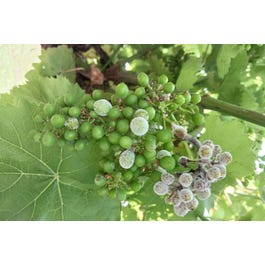
[ad_1]
Within the japanese US, grapes are sometimes grown in a moist, humid local weather and subjected to many ailments brought on by fungal pathogens. Subsequently, fungicides are a vital a part of grape manufacturing within the japanese US, and fungicides containing mancozeb are utilized by industrial growers nearly each season, for a wide range of causes.
Mancozeb is a “multi-site inhibitor”, that controls fungal ailments by impairing or inhibiting a number of important organic processes of the focused pathogens. In so doing, mancozeb may be very efficient at controlling a number of very severe ailments like black rot, Phomopsis, and downy mildew; essentially the most severe of which is downy mildew. These ailments should not sometimes encountered in drier climates like California, however they’ll trigger devastating crop loss for japanese grape growers if not managed adequately in each season, significantly in moist seasons conducive to the event of fungal pathogen populations. The truth that mancozeb inhibits pathogens at a number of ranges, makes it impossible that these pathogen populations will develop resistance to mancozeb, and mancozeb has subsequently been used very successfully to manage grape ailments within the east, for many years. This makes mancozeb a particularly vital device for japanese grape growers.
In distinction, extra trendy fungicides are “single-site inhibitors”, that management ailments by inhibiting only a single important organic strategy of the pathogen life cycle. This makes the single-site inhibitors rather more weak when it comes to the pathogen being able to growing resistance to that single-site fungicide energetic ingredient: a single mutation within the pathogen inhabitants can shortly render that fungicide ineffective at controlling that pathogen on a industrial scale. Metalaxyl is a basic case of a superb single-site inhibitor fungicide (very particular and really efficient at controlling downy mildew of grapes) that’s, sadly, very weak to the event of resistance by the downy mildew pathogen. For instance, in Europe, metalaxyl offered wonderful management of downy mildew of grapes when first registered to be used in 1977. Nevertheless, after just some years (by 1983, simply 6 years after it was launched), populations of the downy mildew pathogen had developed resistance to it. We’ve maintained its efficient use right here in the US for many years. How? By limiting its use (as a result of we had a number of different choices), and by tank mixing it or rotating purposes of it, with multi-site inhibitors, primarily mancozeb.
With the approaching lack of ziram via EPA assessment, our reliance on mancozeb will probably be much more vital for the management of grape ailments in addition to managing resistance to single-site inhibitors. If we lose the usage of mancozeb in grapes, we will probably be left with simply two, much less efficient, multi-site inhibitors (captan and copper) to tackle the function that mancozeb now most prominently serves within the japanese grape trade. Sadly, captan isn’t as efficient as mancozeb on black rot, and copper isn’t very efficient in any respect on Phomopsis and black rot, in relation to mancozeb. Additionally, captan has been not too long ago topic to EPA assessment and impending, further label restrictions (primarily an extension of the re-entry interval).
Maybe most alarming concerning the potential lack of mancozeb by EPA assessment, is that different single-site inhibitor choices for downy mildew management are already being misplaced to resistance. Current analysis has confirmed that a number of single-site inhibitors for downy mildew (Fungicide Resistance Motion Committee [FRAC] 11, P07, and 40) are failing to manage this illness in Pennsylvania, New York, and Maryland vineyards, resulting from resistance. Earlier analysis in Virginia resulted in related conclusions, with strobilurin resistance (FRAC 11) detected as early as 2005 (simply 8 years after its introduction), and carboxylic acid amide resistance (FRAC 40) detected as early as 2016, within the downy mildew pathogen. Certainly, new proof of downy mildew resistance to FRAC 11, FRAC 40, and FRAC P07 chemistries symbolize the lack of efficacy for half of our vital single-site inhibitor fungicides for grapes. This has occurred over a interval of about 15-20 years, a timeframe seemingly solely achievable because of the present heavy reliance on mancozeb as an vital resistance administration device. That leaves us with single-site inhibitor fungicides in FRAC teams 4, 21, and 45, making the retention of mancozeb registration much more important for the financial sustainability of the japanese grape trade. If we lose mancozeb, we will probably be relying solely on single-site inhibitors for efficient black rot management, and we could lose the remaining single-site inhibitors for downy mildew management, over a span of time too brief for the trade to interchange them with new, efficient single-site inhibitors, with completely different modes of motion. The lack of mancozeb will pose a severe menace to the sustainability of the japanese grape trade, as mancozeb is arguably crucial grape fungicide for a lot of the acreage within the japanese grape trade.
For extra data on this matter, be sure you take a look at Dr. Katie Gold’s “Pressing Replace on EPA Mancozeb Proposal”. In her article, she distills all of the vital particulars of the EPA’s proposal and the way the affected members of the japanese grape trade can reply. Please click on on the “survey” hyperlink initially of her article and full the transient survey (it’s going to take you 5 minutes and it is time effectively spent), as this survey is related to the Pennsylvania grape trade.
[ad_2]
Supply hyperlink






